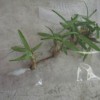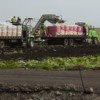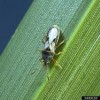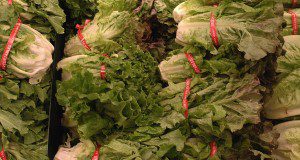Lettuce as a commercial crop is planted mainly in organic soils (“muck”) in the Everglades Agricultural Area (EAA) in south Florida. This updated 6-page publication of the UF/IFAS Horticultural Sciences Department presents a summary of previous cultivar releases by UF/IFAS as well as a description of cultivars currently planted in the EAA. Written by German Sandoya and Huangjun Lu.
https://edis.ifas.ufl.edu/hs1225
Tag: Huangjun Lu
Screening Methods for Southern Chinch Bug Resistance in St. Augustinegrass
 Relying on insecticides for southern chinch bug control raises turfgrass maintenance costs, increases the risk that insects will develop resistance to insecticides, and may damage the environment. Host-plant resistance is a relatively sustainable and environmentally sound option for management of this damaging insect pest.To develop new resistant varieties, plant materials must be screened for new sources of southern chinch bug resistance. Screening methods to measure host plant resistance of St. Augustinegrass to southern chinch bugs have measured nymphal and/or adult survival in so-called no-choice tests in which only the experimental plant materials were provided. There are four types of screening methods described in this 4-page fact sheet was written by Huangjun Lu and Ronald Cherry, and published by the UF Department of Entomology and Nematology, October 2014. (Photo credit: Long Ma, UF/IFAS Extension)
Relying on insecticides for southern chinch bug control raises turfgrass maintenance costs, increases the risk that insects will develop resistance to insecticides, and may damage the environment. Host-plant resistance is a relatively sustainable and environmentally sound option for management of this damaging insect pest.To develop new resistant varieties, plant materials must be screened for new sources of southern chinch bug resistance. Screening methods to measure host plant resistance of St. Augustinegrass to southern chinch bugs have measured nymphal and/or adult survival in so-called no-choice tests in which only the experimental plant materials were provided. There are four types of screening methods described in this 4-page fact sheet was written by Huangjun Lu and Ronald Cherry, and published by the UF Department of Entomology and Nematology, October 2014. (Photo credit: Long Ma, UF/IFAS Extension)
http://edis.ifas.ufl.edu/in1050
New Sources of Southern Chinch Bug Resistance in St. Augustinegrass
 Currently, Captiva is the only chinch bug-resistant variety of St. Augustinegrass grown on sod farms in Florida. But since these pests have previously overcome their resistance to Floratam, it is highly probable that they will do the same with Captiva in the future. It is also desirable to have resistant varieties available with different agronomic qualities such as shade tolerance or drought tolerance. This 4-page fact sheet reports the results of a preliminary screening to detect resistance to chinch bugs, conducted at the UF/IFAS Everglades research station on 36 untested St. Augustinegrass lines. Written by Huangjun Lu and Ronald Cherry, and published by the UF Department of Horticultural Sciences, July 2014.
Currently, Captiva is the only chinch bug-resistant variety of St. Augustinegrass grown on sod farms in Florida. But since these pests have previously overcome their resistance to Floratam, it is highly probable that they will do the same with Captiva in the future. It is also desirable to have resistant varieties available with different agronomic qualities such as shade tolerance or drought tolerance. This 4-page fact sheet reports the results of a preliminary screening to detect resistance to chinch bugs, conducted at the UF/IFAS Everglades research station on 36 untested St. Augustinegrass lines. Written by Huangjun Lu and Ronald Cherry, and published by the UF Department of Horticultural Sciences, July 2014.
http://edis.ifas.ufl.edu/hs1239
Lettuce Cultivars Suitable for Use in Southern Florida
 Lettuce is an economically important winter vegetable crop in Florida, with approximately 11,000 acres in production and a farm gate value of $40–$50 million annually. Florida lettuce production occurs mainly in the Everglades Agricultural Area (EAA). In recent years, research scientists at the University of Florida conducted variety trials that included the major cultivars of romaine and iceberg types. These trials were conducted on organic soil in the Everglades Agricultural Area and the IFAS-recommended practice was followed. This 3-page fact sheet describes lettuce cultivars suitable for production on organic soils in the EAA of southern Florida. Written by Huangjun Lu, and published by the UF Department of Horticultural Sciences, October 2013.
Lettuce is an economically important winter vegetable crop in Florida, with approximately 11,000 acres in production and a farm gate value of $40–$50 million annually. Florida lettuce production occurs mainly in the Everglades Agricultural Area (EAA). In recent years, research scientists at the University of Florida conducted variety trials that included the major cultivars of romaine and iceberg types. These trials were conducted on organic soil in the Everglades Agricultural Area and the IFAS-recommended practice was followed. This 3-page fact sheet describes lettuce cultivars suitable for production on organic soils in the EAA of southern Florida. Written by Huangjun Lu, and published by the UF Department of Horticultural Sciences, October 2013.
http://edis.ifas.ufl.edu/hs1225
Nitrogen Cycling and Management for Romaine and Crisphead Lettuce Grown on Organic Soils
 Lettuce has rapid growth and reaches harvest in 60–70 days in South Florida. This leads to high demands for nitrogen fertilization during the short growing season. A good N fertilization scheme should reduce costs, conserve natural resources, and minimize negative environmental impacts. The keys to using fertilizer efficiently are understanding the crop nutrient requirements to predict fertilizer needs and management as well as knowing the appropriate amounts to apply. Lettuce growers also need to know the nutritional status of the crop through soil and plant tissue testing. This 4-page fact sheet was written by Luis Santos, Alan L. Wright, Yigang Luo, Huangjun Lu, and D. Calvin Odero, and published by the UF Department of Soil and Water Science, September 2013.
Lettuce has rapid growth and reaches harvest in 60–70 days in South Florida. This leads to high demands for nitrogen fertilization during the short growing season. A good N fertilization scheme should reduce costs, conserve natural resources, and minimize negative environmental impacts. The keys to using fertilizer efficiently are understanding the crop nutrient requirements to predict fertilizer needs and management as well as knowing the appropriate amounts to apply. Lettuce growers also need to know the nutritional status of the crop through soil and plant tissue testing. This 4-page fact sheet was written by Luis Santos, Alan L. Wright, Yigang Luo, Huangjun Lu, and D. Calvin Odero, and published by the UF Department of Soil and Water Science, September 2013.
http://edis.ifas.ufl.edu/ss588
Nitrogen Cycling and Management for Romaine and Crisphead Lettuce Grown on Organic Soils
 Lettuce reaches harvest in 60–70 days in South Florida. This short growing season leads to high demands for nitrogen fertilization to maintain adequate plant-available N concentrations in the soil. Growers need to supply the required amounts of N to obtain high yields. Lettuce growers also need to know the nutritional status of the crop through soil and plant tissue testing. This 4-page fact sheet was written by Luis Santos, Alan L. Wright, Yigang Luo, Huangjun Lu, and D. Calvin Odero, and published by the UF Department of Soil and Water Science, September 2013.
Lettuce reaches harvest in 60–70 days in South Florida. This short growing season leads to high demands for nitrogen fertilization to maintain adequate plant-available N concentrations in the soil. Growers need to supply the required amounts of N to obtain high yields. Lettuce growers also need to know the nutritional status of the crop through soil and plant tissue testing. This 4-page fact sheet was written by Luis Santos, Alan L. Wright, Yigang Luo, Huangjun Lu, and D. Calvin Odero, and published by the UF Department of Soil and Water Science, September 2013.
http://edis.ifas.ufl.edu/ss588
Silicon Effects on Resistance of St. Augustinegrass to Southern Chinch Bugs and Plant Disease
 Silicon (Si) is the second most common element on earth, but it is not considered an essential element for plant growth. However, a growing body of evidence has shown that Si can enhance plant resistance to insect pests. This 5-page fact sheet reports the results of a study to determine if silicon applications to St. Augustinegrass varieties increase the silicon in the plants and how this increased silicon affects development and survival of southern chinch bugs as well as development of plant diseases. Written by Alan L. Wright, Ron Cherry, Huangjun Lu, and Pamela Roberts, and published by the UF Department of Soil and Water Science, September 2013.
Silicon (Si) is the second most common element on earth, but it is not considered an essential element for plant growth. However, a growing body of evidence has shown that Si can enhance plant resistance to insect pests. This 5-page fact sheet reports the results of a study to determine if silicon applications to St. Augustinegrass varieties increase the silicon in the plants and how this increased silicon affects development and survival of southern chinch bugs as well as development of plant diseases. Written by Alan L. Wright, Ron Cherry, Huangjun Lu, and Pamela Roberts, and published by the UF Department of Soil and Water Science, September 2013.
http://edis.ifas.ufl.edu/ss589
Lettuce Cultivars for Insect Resistance in Southern Florida (HS1196/HS1196)
 Florida’s subtropical climate facilitates lettuce production from fall through spring, but the warm, moist conditions are also favorable for insect proliferation and damage. Information about current cultivar response to common insect pests in Florida is limited, so UF/IFAS researchers conducted a study to evaluate cultivar response to insect infestation under field conditions and to identify resistance useful for integrated pest management. This 4-page fact sheet was written by Huangjun Lu, Alan L. Wright, and David Sui, and published by the UF Department of Horticultural Sciences, February 2012.
Florida’s subtropical climate facilitates lettuce production from fall through spring, but the warm, moist conditions are also favorable for insect proliferation and damage. Information about current cultivar response to common insect pests in Florida is limited, so UF/IFAS researchers conducted a study to evaluate cultivar response to insect infestation under field conditions and to identify resistance useful for integrated pest management. This 4-page fact sheet was written by Huangjun Lu, Alan L. Wright, and David Sui, and published by the UF Department of Horticultural Sciences, February 2012.
http://edis.ifas.ufl.edu/hs1196
